Final report for FNC16-1044
Project Information
In 2008 my wife and I bought 17 acres of overgrown, ridge top horse pasture with the goal "to develop, share, and celebrate sustainable solutions to home and community-scale food production, and to demonstrate that through creative natural resource management, the land, as always, is still the basis of our health and wealth." The focus of the farm has been on soil conserving hillside agriculture techniques such as terrace gardening, agroforestry, and rotational grazing. While the farm also serves as an education center, hosting workshops and youth summer camps, tree crop production is interwoven into most of the 17 acres. Three acres are in fenced in multispecies forest garden and about 5 acres are in pasture where we raise Katadin sheep and pastured hogs. We also grow veggies, mushrooms, and berries for sale through a small CSA. From the beginning we have practiced no till, used mostly hand tools, and tried to foster a thriving, living soil. It is only recently that we saw the potential to increase our production of mulberry fruit for commercial sale and with this grant have been exploring the possibilities.
Proposal summary:
Problem
Research abounds about the benefits of the mulberry tree and it’s fruit. For instance any book or website will tell you that: Mulberry fruit is delicious, nutritious, easy to harvest, and has little to no pests or diseases. The trees are fast growing, quick to bear fruit, grow in most soil types, and are drought and pollution resistant. They are late to flower and consistently bare copious amounts of fruit with little or no maintenance, irrigation, or attention in general.
All of this information indicates that mulberry is the perfect candidate for an organic or no spray fruit orchard, yet attempts to find examples of it’s commercial cultivation, produce documents and videos from South America, Asia, Eastern Europe, and Northern Africa, and one man in Oregon. The only supply of mulberries for consumption that I could find was grown in Turkey.
I believe the problem is that a poor public perception has led us to overlook the mulberry.
Since its escape from cultivation for a failed silk industry centuries ago, the foreign Morus alba (white mulberry) has aggressively spread across the country, earning the mulberry a reputation as a noxious weed. This uninvited guest has proceeded to dump huge amounts of staining berries on sidewalks and driveways across the country. This combined with the mulberry’s short shelf life, have kept it out of serious considerations for commercial production.
As a result, the mulberry has not been properly tested, bred, or researched. Potential growers can’t find information on varieties for our region, orchard layout, maintenance, or harvesting techniques.
Solution
I plan to grow, test, harvest, preserve, propagate, research, and publicize the mulberry and its potential for cultivation in the midwest.
My strategy will be multifaceted:
1. I will continue planting and testing the named mulberry varieties available at nurseries around the country to see what works in our region.
2. I will seek out productive wild mulberry trees from around the region, clone them, and plant them on my farm for further testing.
3. I will create a mulberry orchard, demonstrating and testing several different cultivation styles (full grown trees, trees managed as small bushes, and trees trained as a fruiting hedgerow).
4. I will hire others to harvest and create products from the mulberry fruit such as alcoholic beverages, syrups, jams, and other culinary dishes to share at a mulberry festival.
5. I will host a mulberry celebration on the farm to promote sustainable agriculture and the mulberry.
6. I will raise and distribute the best mulberry varieties for further testing and enjoyment.
7. Based on research and my own findings I will publish an informational packet about the mulberry and its commercial potential or lack thereof for our region.
Basically, I will discover the suitability of the mulberry for organic fruit production in our region, find the best varieties to grow, and engage as many others in the process as I can.
Project objectives from proposal:
- Promote, find, propagate, and grow in a test orchard mulberry trees from around the region to discover which, if any, is suitable for commercial production.
- Benefit the environment by planting deep rooted trees that contribute falling leaves and branches to the soil, provide diverse wildlife habitat and forage, and ultimately create a more resilient and diverse landscape.
- Empower farmers to increase profits by producing high-value mulberries on marginal land not suited for other crops.
- Host and organize a mulberry festival to promote social cohesion and bring those of a like mind together to share ideas and experiences.
WORK ACTIVITIES
Beginning in February of 2016 I began to search for mulberry trees in the region that were reputed to produce excellent fruit. Using social media, connections with the North American Fruit Explorers (NAFEX), online wild foraging maps, and word of mouth, I was able to identify and collect scion wood (dormant cuttings used to graft or clone new trees) from over 50 varieties of mulberry trees. I collected around 20 unique samples (but many cuttings from each tree) from Athens County where I live, 20 unique samples from Columbus, Ohio where I found a great online map of hundreds of edible fruit trees, and about a dozen from around the Midwest. The ones collected from out of state were generously cut and mailed by other fruit enthusiasts and include samples from Wisconsin, Indiana, Minnesota, and Michigan.
These samples were then put into ziplock bags with a damp paper towel and stored in the refrigerator until April. During this waiting period, I ordered one of every mulberry cultivar that I could find available at nurseries online, ending up with about 20 cultivated mulberry varieties.
In April I hosted a grafting workshop and trained a half dozen people to propagate mulberries using a whip and tongue graft. I had pre-ordered 500 mulberry root stock from Lawyer nursery (The size I ordered turned out to be smaller than I anticipated and next time I will order larger ones; the ideal grafting stock having a base diameter a little smaller than a no. 2 pencil).
After the workshop, I hired three of the participants to stay and help me graft onto 250 of the rootstock over the next three days. After grafting and sealing the grafts with wax, the trees were put in damp peat moss in plastic tubs (with drainage holes in the bottom) and placed in a warm humid room inside to heal. A few weeks later, when outside trees were beginning to break bud, my grafted trees were taken outside and put into individual pots with compost and placed in a fenced in nursery. The 250 that were not grafted were immediately planted into mowed grass at a spacing of 1' along a fence row to be grown into a hedgerow or living fence.
Around this same time the cultivated trees from other nurseries began to arrive and were planted out into their permanent homes at a spacing of approximately 25'. Each tree was mulched and a cage put around it to protect it from deer.
Shortly after this, we hosted a community festival at the farm, featuring local products, local food and beverages. The hope was to harvest and include mulberry in all of the dishes, but contrary to my belief that every year is a good fruit year for mulberries, this year was not and we only had mulberry to include in a tamale dish. At the festival we were still able to give a tour of the nursery and the newly planted orchard and discuss the project and our vision for a sustainable agroforestry system for our region.
The summer was spent watering and weeding the nursery stock, the new orchard and the hedgerow, and periodically knocking off new bud growth below the grafts of the potted plants. Either because we were not all very experienced at grafting mulberries, because of the small diameter of the rootstock, or the difficulty in general of grafting mulberries, of the 250 grafts attempted about 80 took.
Of the 80 successful grafts, I picked one of each variety to plant at my farm, sent 10 to be planted at another farm, 10 to another, and have 10 left. In the fall, the fifty trees reserved for my farm were planted in several configurations: trees planted at 25' spacing will be allowed to reach full size, trees planted at 10' spacing will be pruned to small shrubs for easier harvesting, and trees planted at 1' spacing to be trained as a living, fruiting fence.
I hired help to prep the site, dig holes, spread compost, etc and then brought my college class out for a planting day to put the trees in the ground, stake and cage them, and water. Another colleague brought two of his classes out to the farm for a tour and further help planting.
After planting and several waterings, the trees are on their own for the winter. Currently I am preparing for another round of grafting in the spring and planning our next festival.
2017 work activities
This year I ordered Morus alba rootstock from Twisted Tree Nursery in Oregon. The trees had a great root system and were the perfect pencil diameter for grafting. Grafting mostly by myself this time, I was about 80% successful. I talked with several professionals and they said that there is no reason I shouldn't get 90% success as I get more practice.
More internet searching turned up even more temperate mulberry varieties this year, plus I found a mulberry genetics repository at UC Berkley that sent me cuttings from several new varieties. I now have almost every mulberry variety that I have heard of and many more, except for a few that I simply could not track down. Here is my list as of the conclusion of this grant project: Illinois Everbearing, David Smith, Kokusa, Wellington, Silk Hope, Beautiful Day, Sweet Lavender, Gerardi, Issai, Dwarf Morus Nigra Everbearing, Northrup, Capsrum, Long White, Downing, Trader, Pink Fruited, Morus rubra, Gelato Red, Persian, Super Berry Black, Mystic Red, Gurney's Black, Capsrum, Carman, Oscar, Honeydrop, Hicks, and a few named after the people that gave me trees from their backyard, like the Ragan, Ward, Dahl, the RVC, and the Virginia, and then a bunch of unnamed wild ones.
This year was a great year for fruit and I hired two friends to help harvest mulberry from my farm and from wild trees around town. We froze a bunch for home use and sold some to Nixtamalized for use in their tamales and sauces, some to Pork and Pickles for use in salad dressings and sauces. I also found many creative uses for them from adding them to my oatmeal to making pies, jams, and other desserts, to pressing them with apples to flavor a cider. I cooked them down into a syrup, ate them fresh and frozen, and tried to dehydrate them, but broke my dehydrator and couldn't finish the experiment. I have since connected with ACEnet and will use their commercial dehydrator next year.
We hosted the festival again this year and had a similar crowd of around 300 people. This time we featured more mulberry inspired cuisine and sampled some of the remaining fresh mulberries from the trees. The two-year old trees bore a small handful of mulberries each and the one year old ones had only a couple berries, but thankfully I have many trees that are three and four years old that produced decent crops. I think that year four is the first significant year of production and it keeps getting better from there.
RESULTS
We have planted orchards in three distinct configurations to be managed in three separate ways.
Plan: Trees planted at 25' spacing will grow to full size and will be pruned for maximum fruit production. Planted in a recreation area of the summer camp, fruit will be harvested by kids climbing trees, plucked from low branches by browsing visitors, or shaken onto a sheet. If it proves too inconvenient to harvest from the tall trees, fruit will be allowed to fall to the ground and be foraged by chickens and/or hogs.
Trees planted at 8-10' spacing will be heavily pruned to grow into small shrubs up to 8' tall. This will make hand harvesting convenient. Seasonal pruning will also provide abundant scion wood for grafting new trees, allowing us to continue planting and selling trees to other landowners.
Trees planted at 1' spacing will be trained into an impenetrable hedge that acts as a living fence. Fruit on one side can be picked by humans and fruit on the other side can be harvested by livestock.
Since beginning this project, I have also learned that the leaves of white mulberry are edible to humans and livestock and are very high in protein. I've experimented by stripping leaves and feeding to hogs and also by cutting and carrying leaf laden branches to the hogs. Hogs greedily devour the leaves, often leaving commercial corn offerings in favor of the mulberry leaves. This opens many new opportunities in mulberry production, and I have read that in tropical areas mulberries are cut up to four times a year to feed to livestock. I hope to acquire a fruit crop, then cut leaves for my livestock in early July and again before leaf drop in the fall. Leaves of the hedgerow can be foraged at will.
Additionally, we have learned that because young mulberry wood is particularly pithy and weak, grafting larger diameter scions onto larger diameter wood (approximately pencil diameter) is easier and should provide better results.
I also experimented with propagation by hard and soft wood cuttings at different times of year, each experiment yielding about a 10% success rate, which given the time and effort required is still worth trying, especially if improvements can be made. An authority has since told me that pure Morus alba roots well, but hybrids do not.
OUTREACH
We had only six people attend our first grafting workshop, three of them stayed for three days of grafting and are now proficient grafters. The second workshop attracted 10 people.
Between the community college class that I teach and my colleagues’ classes, 90 Hocking College students were given tours and lectures on agroforestry and participated in the planting of the orchards over the two year period.
At our festival around 300 people were exposed to the idea of mulberry as a commercial crop each year, and around 30 came on the orchard tour each time.
Over 350 children helped with the project in some way or another at my summer camp programs, whether it was propagating by cuttings, eating fruit from mature trees, planting or watering, everyone who came to camp got involved in some way or another and many took home mulberry trees to plant in their backyards
Throughout the summer I also gave 10 tours of the farm to couples and small groups. At each tour the mulberry project was highlighted and discussed at length.
At my annual talk at the Ohio Pawpaw Festival, I presented the project to a crowd of 50 sustainable agriculture enthusiasts each year of the grant project and am scheduled to give a talk about integrating mulberries and hogs at the 2018 Ohio Ecological Food and Farm Association annual conference.
Much of my social media posts (youtube and facebook) have shown great videos of children harvesting and eating mulberries, plus pigs eating mulberry leaves and foraging under the trees. I also documented the project in photos from start to finish on my facebook page. Footage of the pigs and mulberry is also featured in my camp promotional video.
Recently, I have completed an informational brochure detailing why and how to grow mulberries. The pamphlet describes all important aspects of mulberry production including recommendations for trees for our region.
As I've stated throughout the report, I don't have enough evidence yet to make any strong recommendations about what cultivars to plant; however, research and conversations with mulberry experts have led me to these general conclusions:
Gerardi dwarf mulberry will make a great tree for hand harvesting berries for fresh market as it is naturally a small tree and has large delicious berries.
For value added production or to feed to livestock (berries that will drop on their own or be shaken from the tree), everbearing varieties like Illinois Everbearing, Wellington, and Silk Hope are recommended.
I've been researching and attempting to create a sustainable food production system for hilly land that is relatively easy to manage, has low offsite inputs, and is sustainable economically and environmentally. Soil loss resulting from tilling the land, especially on terrain with any slope is one of the leading causes of erosion. As populations grow and the need for food increases, the need to farm steep and marginal land will increase. Finding an agriculture approach that conserves soil is paramount.
Initially, convinced that agroforestry in some form was the solution, I planted a lot of apples, pears, and peaches on my north facing slope. Unwilling to spray all of the necessary fungicide, pesticide, etc, to succeed with these finicky crops, I have not seen the production that I hoped. In mulberries, however, I have found a solution. The trees bear fruit at an early age, beginning immediately with worthwhile results in 3-4 years. They are free from pests and diseases, unless you consider birds and children pests. They can be grown on hilly marginal land and actually help to hold the soil in place while adding valuable organic material each year in the form of leaf drop. They also are a great nutrient sink and will eagerly suck up any available nutrients during the growing season, making them a great candidate for integration with livestock. Additionally the wood is good for firewood, fence posts, and bowl making. The leaves of the white mulberry are edible to people and livestock. Best of all, mulberries are delicious and nutritious.
To test my belief that mulberries were the right crop for our worn out old hills, I gathered temperate mulberry varieties from around the country and planted them in three distinct orchards on the property to discover which varieties do best and in what planting arrangement they would be most easily harvested or utilized. To this initial planting I also added two more plantings, one in the style of tropical alley cropping, similar to what is being done with Inga, and one planting to provide in situ forage for livestock.
The two year length of a SARE grant unfortunately is not generally enough time to learn a ton about perennial tree crops, and I cannot make any conclusions about which style is best as of yet. Generally, however, I have found the trees to be easy to grow, vigorous, productive, and free from pests and disease, except for something eating the leaves occasionally (maybe deer or caterpillars).
I'm now looking to continue the study through a USDA Value Added Producer Grant to figure out the best way to harvest, process, and sell mulberries and will continue to refine my system as the years progress.
Research
I gathered as many mulberry cultivars from around the country as possible to test which ones would thrive in our temperate climate. I hoped to learn the production times for each cultivar, the qualities of the various fruits, and the volume from each tree, so that I could make recommendations as to which trees or combinations of trees landowners should plant for different applications.
As I could have expected, in a two year project, the trees are not yet producing in large enough quantity to gather sufficient data. While most trees grew well and produced several berries, Illinios Everbear and Kokusa were the most vigorous. Still I need a few more years of data collection before I can make any solid recommendations.
Educational & Outreach Activities
Participation Summary:
To share information about mulberries and my project generally I created a page about agroforestry and one specifically about mulberries on my farm website. I also periodically posted project updates on my three different Facebook pages and put a few related videos on Youtube. We had two large mulberry themed festivals at the farm that I promoted primarily on social media, but also through fliers, posters, and email lists, and some special event websites. About 300 people attended each year.
For the grafting workshops I advertised on Facebook and through a collaboration with Community Food Initiatives. We only had 6 attendees at the first and 10 at the second. For my apple grafting workshops in the past we have had more like 12, but it could have been the weather.
I also had a captive audience in my Sustainable Natural Resource Management class at Hocking College and in the Principles of Ecotourism class that a colleague teaches. I lectured regularly about agroforestry and mulberries to each of the four semesters of students that I had during the project and brought them out to the farm regularly to help with the project. Over the two years about 120 students participated in a hands-on mulberry project of one type or another.
I also presented about the project at the Ohio Pawpaw Festival both years in a presentation called "Saving the Land with Mulberries and Pawpaws" Saving-the-Land-with-Pawpaws-and-Mulberries-2 I gave a similar talk at Ohio University to 200 freshman in a Plant Biology course, and I'm working on another presentation to deliver at the OEFFA Conference.
In addition to the regular farm tours that I give primarily to permaculture and sustainable agriculture enthusiasts, I also organized a special tour for Ohio University faculty and staff and hosted 20 university professors and administrators to a lunch and tour of the farm featuring my mulberry project. Here is an article about the experience. This experience allowed me to sit on two panel discussions at the university centered around sustainable agriculture.
The best outreach is always with the children at my summer camp. Each summer we see about 200 children and those lucky enough to come during mulberry season spend about an hour each day picking and eating mulberries. Each week of camp, I also lead a tour of the mulberry orchard and engage the kids in some way, whether it is planting trees, watering them or just harvesting leaves to feed to the pigs, they all get a hands-on experience of the tree. As a result, I sent a half dozen trees home with different parents to plant in their backyards (and would have sold more if I had them).
The local newspaper did run an article after each of the festivals, but did not focus on the mulberries at all. I sent them a press release specifically about the project, but it did not get published unfortunately.
Lastly I have put together a mulberry growers minibook that I will soon distribute at my talks and to visitors at the farm. This will be a great promotional tool moving forward as I try to convince more landowners to grow mulberries commercially.
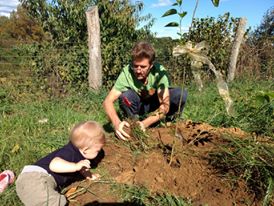
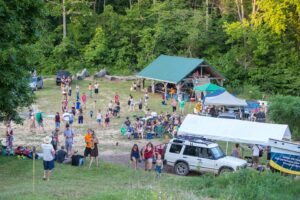
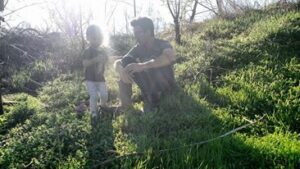
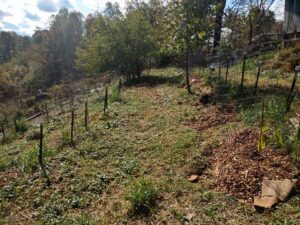
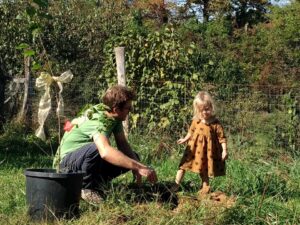
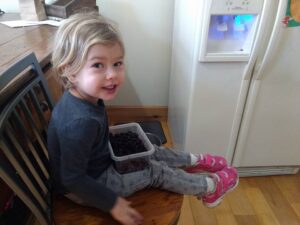
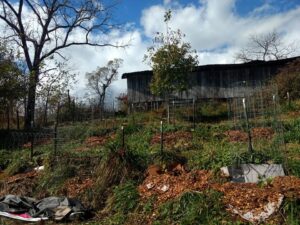

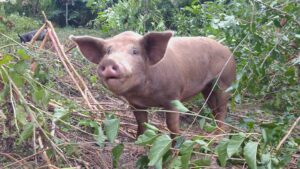
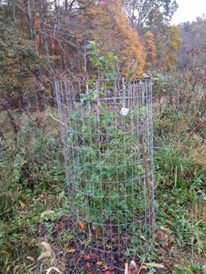
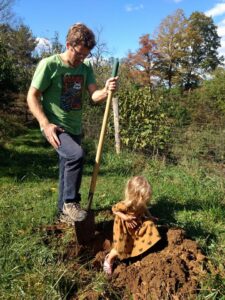
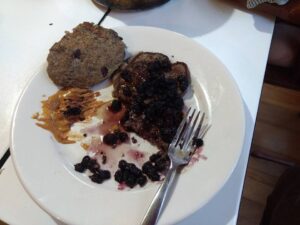

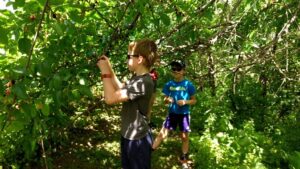
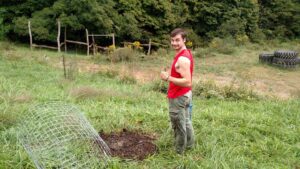
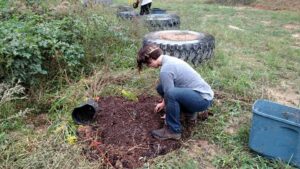
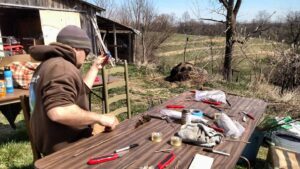
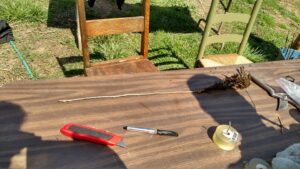
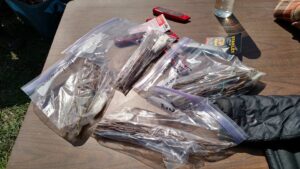

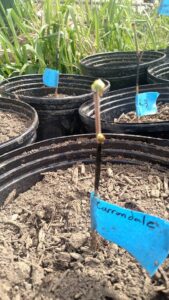
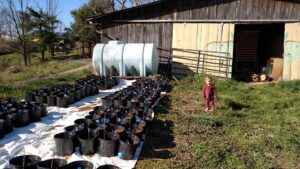
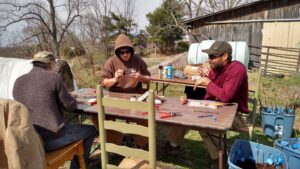
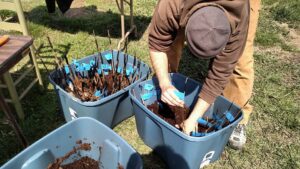
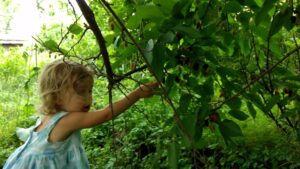
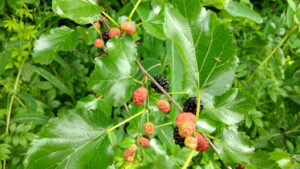
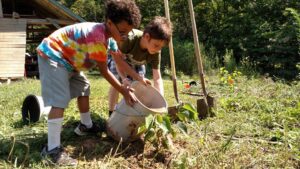
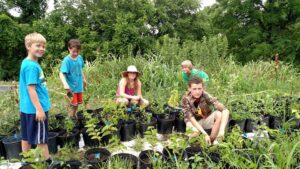
Learning Outcomes
From my research, I discovered that there are dozens of cultivated temperate climate mulberry varieties easily available from nurseries around the country (however, there are many more for Zone 7 and higher). Thorough online reading, reveals that there are also many hard to find varieties from antiquity. Through online forums, I was able to acquire cuttings to propagate from several of these varieties, but I'm still looking for many more.
Previous to this grant, I was not aware of the many uses of Morus alba leaves. They are edible for human consumption, and a high value feed for livestock. They can be dried and used as a tea that may help with blood sugar issues. The root bark is also marketed as a medicinal product.
I also experimented with grazing pigs in the more established mulberry orchard and found that the pigs did a good job of clearing the underbrush around the trees without killing the trees. Grazing pigs around trees may be a good management method to replace mowing, but must be done carefully. If left long enough around the trees, the pigs may eventually damage them.
I discovered that mulberries freeze and store well, and I created many great desserts from them. I made mulberry syrup, pies, smoothies, and added them to oatmeal, cookies, and pancakes, as well as eating the frozen berries themselves.
I also learned that there are many great wild trees in my region and have identified a few to propagate and sell. Many new mulberry varieties are just wild trees that people have found and named.
After engaging in this project, I am convinced more than ever that mulberry is going to be an important commercial crop in the coming years. Whether hilly Appalachia will be the right fit is hard to say. Since they can be grown almost anywhere, warmer climates might have a leg up as some of the bigger fruit can only be grown in zone 7 and warmer. Fresh fruit will have to be grown regionally, but dehydrated and preserved mulberry products may be best suited to other landscapes. Growing mulberries on our hills to feed to pigs, could be competitive with any other region, however. This is certainly a subject for further investigation and I am going to continue my efforts at Solid Ground Farm to find just the right application for mulberries in our region.
Project Outcomes
I gave mulberry trees to a half dozen individuals and three farms for a trial planting to see if they want to plant full-scale orchards. It will be a few years before the trees are mature enough to make an impact, but everyone has been excited by the early fruiting of their young trees.
There are many mulberry cultivars and many potential markets. It will be necessary to discover which varieties best suit which applications and how to most efficiently and economically manage the plantings. Although, my experiment is not conclusive yet, through this project I was able to contact AJ Bullard who is the foremost authority on Mulberries in the US. He confirmed my researched guesses that Girardi would be a great berry for fresh market and that Silk Hope and Hicks should be tried for livestock berry production.
It would be great if SARE offered a longer term grant to better study perennial systems that take time to mature.
More opportunity exists in learning how to best market, preserve, and add value to mulberry crops. I'm working on a USDA Value Added Producer Grant to explore these market opportunities.
Information Products
- Sustainable Agriculture Solutions for Appalachia: Mulberry Agroforestry (Book/Handbook)
- Video: Mulberry Production with Weston Lombard (Multimedia)
 MulberryPressRelease
MulberryPressRelease